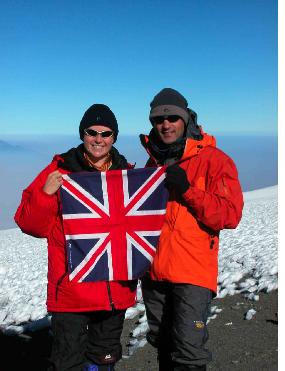 |
|||
|
||||||||||||||||||||||||||||||||||||||||||||||||||||||||||||||||||||||||||||||||||||||||||||||
OUR CLIMB …Summit date: 30th July 2003 BACKGROUND …Kilimanjaro, a dormant volcano just south of the equator, is the highest free standing mountain in the world and rises from the hot dry plains of the Masai steppe to any icy cap at nearly 6,100 metres (20,000 feet). There has long been debate over the meaning of its name, one being “Mountain of Whiteness” but the Swahili word ‘kilima’ actually means ‘top of the hill’ and ‘njaro’ presumably refers to snow in some way (‘ngare’ means water in the Meru language). Mount Kilimanjaro has been created by the same movements of the earth’s crust that created the Great Rift Valley which runs from the Red Sea through Tanzania to Southern Africa. As two continental plates pulled away from each other leading to a thinning crust, many volcanoes were subsequently formed including Mt Meru, Kenya and Kilimanjaro. The rift valley is still active today, and Kilimanjaro is the result of comparatively recent volcanic activity. Mount Kilimanjaro has five major ecology zones ranging from scrub and forest on the lowland slopes, that is largely cultivated to forest above 1,800metres (5,905 feet). This forest zone is also known as the water provider with up to 96% of all the water on the mountain originating from this zone. Above 2,800 metres (9,186 feet) there is just heath and moorland and then highland desert above 4,000m and finally an arctic zone above 5,000 metres (16,404 feet). Here near the summit, it is characterized by freezing nights and blazing sun during the day with an oxygen level which is half that of sea level. At one stage most of the summit of Kilimanjaro was covered by an ice cap, more than 100 metres deep and its glaciers extended much farther down the mountain. An aerial survey carried out by Ohio State University discovered that 33% of Mt Kilimanjaro’s ice had disappeared in the last two decades and 82% of the ice had gone since 1912. With only a small fraction of the glacial cover remaining, it is estimated that the ice cover may completely disappear within the next 20 years. Whilst being one of the most straight forward of the “Seven summits” offering the popular ‘Marangu’ route as a walking route to the summit, this can get overly busy and not provide the quiet mountain experience expected! There are many other routes that range from more challenging routes such as the Umbwe route that involves an interesting scramble through the western breach of the crater rim, usually in the dark, to much harder technical climbs involving multiple pitches of steep rock and ice climbing. Being such a large mountain standing alone in the plains, Kilimanjaro creates its own micro-climate and even has its own rain shadow to its south and east which gives amazingly fertile land. Here the towns of Arusha and Moshi have thrived with their surrounding banana groves and coffee plantations. |
||||||||||||||||||||||||||||||||||||||||||||||||||||||||||||||||||||||||||||||||||||||||||||||
|

 Height: 5,895 metres / 19,340 feet
Height: 5,895 metres / 19,340 feet